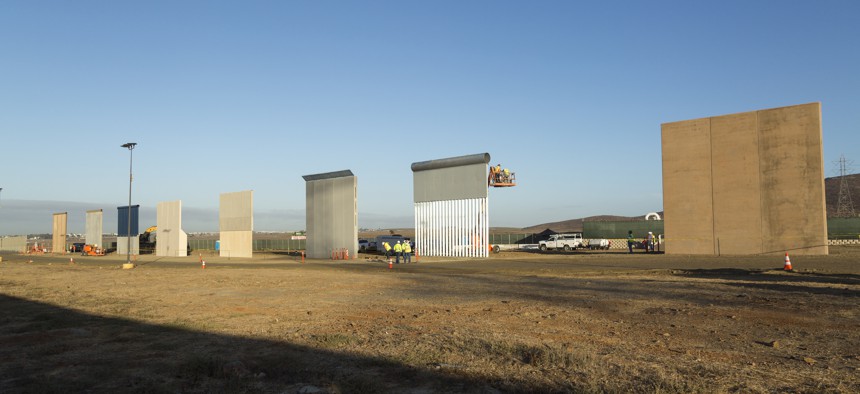An overhaul would involve hiring more judges and lawyers associated with the asylum process. This would reduce the backlog, allowing quicker deportations of those applicants whose claims have been denied. (At present, they are allowed to work legally in the United States until their case is heard by an immigration judge, which can take two to three years.) It would also have the effect of allowing Customs and Border Protection, the agency that first encounters the asylum seekers and more and more is being tasked with dealing with them, to focus on its core mission: “protecting the public from dangerous people and materials.”

Ground views of different Border Wall Prototypes in California in 2017. Mani Albrecht/CBP file photo
Analysis: $5 Billion Could Buy a Lot of Border Security
Fixing the asylum system, upgrading ports of entry, and tightening security checkpoints might do more to advance Trump’s goals than a wall.
As a presidential candidate, Donald Trump pledged to reduce illegal immigration from Central America, and since taking office he has paired that vow with professed concerns about not just the flow of asylum seekers into the United States, but the smuggling of drugs and the potential entry of terrorists, too. That, in his telling, is why he wants $5 billion from Congress for a wall along the U.S. border with Mexico.
But what if there were other—better—ways of achieving the president’s goals than spending $5 billion on a wall? Here are a few possibilities.
Fix the Asylum System
The surge of asylum seekers from Central America has put further strain on an already stretched system that processes their claims, resulting in what is now a years-long backlog.
“The system is neither fair to legitimate claims nor timely,” said Andrew Selee, the president of the Migration Policy Center, a Washington, D.C., institute that studies migration.
“You’re not going to be able to ‘immigration judge’ your way out of the issue, but it’s going to help,” Mark Krikorian, the executive director of the Center for Immigration Studies, a think tank that favors restricted immigration to the United States, told me.
Upgrade Ports of Entry
Trump has called the southern border a pipeline for “meth, heroin, cocaine, and fentanyl.” But it is unlikely that a wall will deter drug smugglers. “Drug smugglers have more than $5 billion to throw at the problem,” Theresa Brown, who studies immigration at the Bipartisan Policy Center, told me. “They will find another way.”
In fact, the overwhelming majority of drugs, weapons, migrants, and criminals cross the U.S.-Mexico border through one of 330 designated ports of entry between the two countries.
Part of the $5 billion could be spent on technology to detect drugs and weapons, which are concealed in compartments in cars or mixed with legitimate cargo in semi trailers and trains. It could also be used to hire more CBP officers to enhance detection and ease traffic delays caused by the time it takes to inspect vehicles that carry goods into the country.
Tighten Checks Between Ports of Entry
The George W. Bush and Barack Obama administrations spent billions on technology and personnel along the nearly 2,000-mile border to detect migrants crossing illegally and, for the most part, that appears to have worked. Attempts to illegally cross the U.S.-Mexico border fell from 1.6 million in the 2000 fiscal year to 400,000 in the 2018 fiscal year, the latest period for which data are available.
“If you look at what’s been done on the enforcement side, it is more robust and effective than it’s been before in U.S. history,” said Edward Alden, who researches immigration and other topics at the Council on Foreign Relations. “We’re doing pretty much everything that can be done.”
Indeed, there are few places for migrants to hide in between the ports of entry. These areas are vast and have little physical infrastructure. Existing monitoring technology, including sensors and drones, allows CBP agents to track migrants for days before they are apprehended. Additional tech could enhance the detection of migrants to provide even better results. More CBP personnel could also be assigned to combat human smugglers who often bring migrants across the border.
It is virtually impossible to stop all illegal crossings. The amount spent on this effort depends very much on how important politicians say illegal immigration is to them—and, perhaps more importantly, what level of illegal crossings is acceptable to them.
Barriers (Like a Wall)
There is already more than 600 miles of fencing along the U.S.-Mexico frontier. Barriers are effective not so much in stopping migrants, but in slowing them down. They work especially well in urban areas, where migrants can hide after crossing in order to avoid detection.
Fencing along the border has been shown to be fairly effective in places such as El Paso, Texas, and San Diego, California. Any comprehensive plan to address border security would likely include a barrier, which in some parts of the frontier would be, yes, a wall. But a $5 billion wall between ports of entry is unlikely to have the impact the president says it will: stopping drugs, criminals, and illegal immigration.
Ultimately, funding for such issues lies with Congress. Border security and immigration have become hot-button issues in the United States, rendering a serious debate over priorities along the frontier with Mexico virtually impossible.
“There’s definitely a conversation to be had about what is actually needed to secure the border,” the Bipartisan Policy Center’s Brown said. “Unfortunately, we’re having a conversation just about a wall.”






